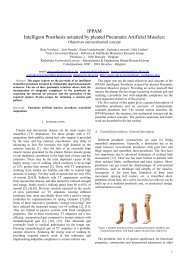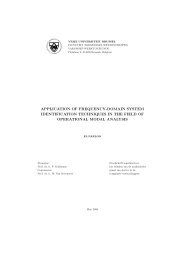VRIJE UNIVERSITEIT BRUSSEL Acoustics - the Dept. of ...
VRIJE UNIVERSITEIT BRUSSEL Acoustics - the Dept. of ...
VRIJE UNIVERSITEIT BRUSSEL Acoustics - the Dept. of ...
You also want an ePaper? Increase the reach of your titles
YUMPU automatically turns print PDFs into web optimized ePapers that Google loves.
88 CHAPTER 5. SOUND INSULATIONAbovemass-frequency lawwasderived assumingnormallyincident waves.One can show <strong>the</strong> following relation for sound with oblique incidence :∆L = 20logπmf cosθρc(5.13)The more oblique <strong>the</strong> incident wave, <strong>the</strong> lower <strong>the</strong> insulation value <strong>of</strong> <strong>the</strong>wall. But starting from a certain angle reflection will occur. Above model isonly valid for 0 < θ < 78 degrees. In practice sound will be incident fromdifferent directions simultaneously (e.g. in <strong>the</strong> case <strong>of</strong> a diffuse field <strong>the</strong>re isa omnidirectional incidence). One can show that in this case :∆L = 20log πmfρc−5 dB (5.14)The insulation value <strong>of</strong> <strong>the</strong> wall is thus 5 dB less than for a normal incidence.For air this formula can be rewritten as :∆L = 20logmf −47.4 dB (5.15)The mass frequency law is an engineering models which attempt to give acoarse prediction <strong>of</strong> <strong>the</strong> sound insulation behavior. It does not give an exactrepresentation<strong>of</strong><strong>the</strong>vibroacousticbehavior<strong>of</strong><strong>the</strong>air-wallinteraction. In<strong>the</strong>following sections we will introduce several extensions <strong>of</strong> <strong>the</strong> mass-frequencylaw.5.2.2 Effect <strong>of</strong> <strong>the</strong> wall stiffnessThe <strong>the</strong>oretical mass-frequency law showed that <strong>the</strong> mass per unit area playsan important role in sound insulation. We assumed that <strong>the</strong> wall was characterizedby its mass only and <strong>the</strong> elastic properties were ignored. If <strong>the</strong> latterproperties are considered, we notice that for <strong>the</strong> acoustic insulation propertiesthis has some negative consequences : resonance phenomena can occurat which <strong>the</strong> wall is transparant for <strong>the</strong> sound wave. This will be shown inwhat follows.Consider p − en p + <strong>the</strong> sound pressures at respectively <strong>the</strong> left and rightside <strong>of</strong> <strong>the</strong> wall, given by :p − = 2P i cosk 1 xexpiωt−iωXρ 1 c 1 expiωt+k 1 xp + = iωXρ 2 c 2 expiωt−k 2 x = P d expiωt−k 2 xThe equation <strong>of</strong> motion can now be written :mẍ+dẋ+kx = p − (0)−p + (0) (5.16)
















